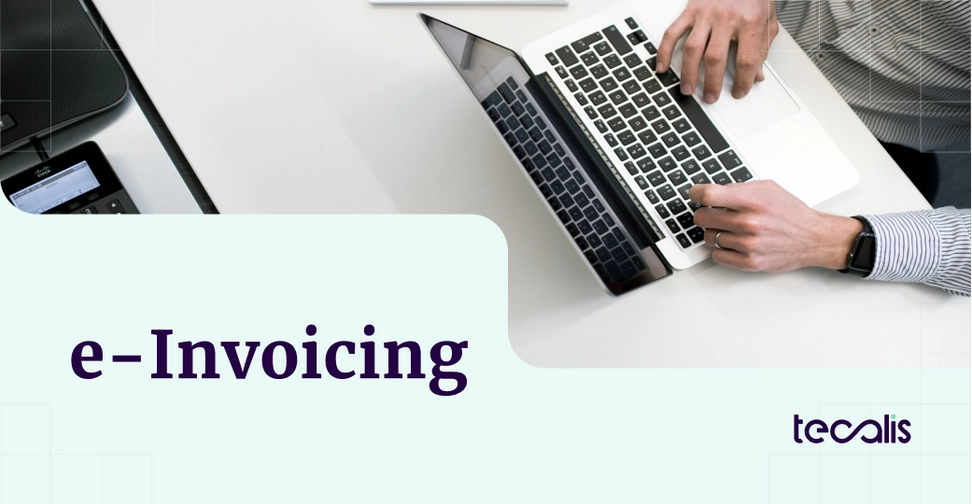Index
Get the latest news right in your inbox
e-Invoicing is an example of the adoption of electronic systems that have become essential to optimize business processes and to be competitive in complex and changing markets. One of the relevant aspects in this context of digitization of processes and paperless model is electronic invoicing, known as eInvoicing or e-Invoicing.
In this article, we will explore this concept in detail, highlighting its benefits, how it is implemented, and the key considerations to keep in mind when adopting this e-Invoices system.
What is an e Invoice?

An e-Invoice is an electronic tax document that replaces the traditional paper invoice and expands its capacity to support a commercial agreement. It is a digital file generated and transmitted electronically according to specific standards, which complies with all legal, technical and fiscal requirements established by the tax authorities. Through the e Invoice, the commercial transaction between a supplier and a customer is recorded and validated, streamlining the processing processes and completely reducing the use of paper and printing.
Regarding the use of the term with or without hyphen (eInvoice, e Invoice or e-Invoice), there are discrepancies, but as a general rule we can say without any problem that they are absolute synonyms.
Thus, an e Invoice is an electronic invoice that can be considered as such if it complies with the regulatory requirements set by the laws of the market and the region where it is issued and processed. These are usually regulated by tax authorities or commercial laws.
What an e-Invoice looks like
The eInvoice is a tax document that is issued and received in electronic format, complying with the technical and legal requirements established by the tax authorities of each country. The technical requirements, specifications, and types of electronic invoices may vary according to the legislation of each jurisdiction, so it is important to consult the specific regulations of the country in question. However, below we will provide an overview of the common requirements and types of digital invoices.
Common technical requirements:
- Electronic signature: e-Invoices must have a valid digital signature, which guarantees the authenticity and integrity of the time-stamped document validated by an eIDAS QTSP (Qualified Trust Services Provider).
- Digital certificate: It is necessary to have a digital certificate issued by a recognized certifying entity to perform the digital signature. Platforms such as Tecalis allow inserting digital certificates in invoices and any type of similar commercial documentation.
- Structured and readable format: In order to be considered as such in many areas, the electronic invoice must be structured in a specific format that is readable by both people and software, generally based on standards such as XML (eXtensible Markup Language) or JSON (JavaScript Object Notation).
- Electronic identification: Both the issuer and the receiver of the e-Invoice must have a unique electronic identification, which can be a tax identification number or a specific code assigned by the tax authority. KYC and Know Your Business identity verification methods can be used to further support and guarantee the whole process.
About e-Invoicing platforms
There are different types of platforms to manage digital invoices. From those based on electronic signature, programs such as Tecalis, to free applications from RegTech partners.
Each of these platforms works in a different way and presents interfaces with different functionalities. Beyond document management, which can be done in the company's file storage systems (such as Google Drive, Dropbox or its own servers), the aspects that should be taken into account the most are those related to the legal validity of the invoices themselves. This is the most important and complex thing to achieve, since we can find many document and invoice management softwares that are very useful in terms of creating the invoices themselves but do not provide them with any kind of legal backing.
Basic types of electronic invoices
- Standard electronic invoice: This is the most common type of electronic invoice, which complies with the technical and legal requirements established by the tax authorities. It contains all the necessary data for invoicing and tax compliance.
- Simplified electronic invoice: Some legislations allow the issuance of simplified electronic invoices for smaller transactions. These invoices have fewer requirements and contain basic information about the transaction.
- Other specific types: Depending on tax legislation, there may be other types of electronic invoices, such as credit notes, debit notes, or corrective invoices, which are used to correct or modify previously issued invoices.
Remember that this information is general and the technical requirements, specifications and types of electronic invoices may vary from country to country. Therefore, it is important to consult the specific regulations of the country where you wish to issue or receive electronic invoices.
For more specific information on all types of e-Invoicing with their technical formats and how they work, visit the first article in our blog "Electronic invoicing: what it is, how to do it and when it will be mandatory".
e Invoicing required by law in countries such as Spain

The recently approved Spanish Crea y Crece Law has generated a great impact in the field of eInvoicing and the fight against commercial delinquency in Spain. This legislation, which is scheduled to come into force between 2023-2024, seeks to promote digitalization and improve the country's business environment.
The Crea y Crece Law makes it mandatory for all companies, regardless of their size or sector, to issue and receive e-Invoices. The main objective of this measure is to streamline and simplify e-Invoicing processes, reducing the use of paper and the costs associated with document management. In addition, the e-Invoice allows greater traceability and security in commercial transactions.
Another highlight of this law is the fight against commercial delinquency. Maximum payment terms are established to avoid unjustified delays in payments between companies, especially small and medium-sized ones. These deadlines are considerably shortened compared to previous regulations, which will benefit the liquidity of companies and contribute to a more equitable business environment.
The digitization of invoicing and the fight against commercial delinquency represent a significant boost for the creation and growth of companies in Spain. By adopting e-Invoicing, companies will be able to optimize their administrative processes, improve efficiency and reduce operating costs. Reducing late payments will also promote confidence and stability in the business environment, thus encouraging investment and job creation.
In summary, the entry into force of the Crea y Crece Law represents an important step towards the digitalization of invoicing and the strengthening of the business fabric in Spain. The obligatory nature of electronic invoicing and the fight against commercial delinquency will contribute to a more efficient, equitable, and sustainable business environment, benefiting companies of all sizes and sectors.
e Invoices: how to make them correctly
In order to create an e-Invoice correctly, it is important to follow the following steps to create all the fields it must have and include the technical characteristics that make it valid:
- Identification of the issuer and receiver: Includes the complete data of the issuer of the invoice (name or company name, fiscal address, tax identification number, etc.) and the data of the receiver (name or company name, fiscal address, tax identification number, etc.).
- Issue number and date: Assigns a unique number to the invoice and specifies the date on which it is issued.
- Detailed description of the products or services: Clearly and accurately lists the products or services provided, including their quantity, unit price, and any other relevant data such as discounts or applicable taxes.
- Calculation of amounts: Calculates the total amount to be paid, including the subtotal of the products or services, taxes (such as VAT), and any additional charges.
- Payment method and deadline: Indicate the payment conditions, such as the accepted payment method (bank transfer, credit card, etc.) and the maximum payment deadline.
- Inclusion of additional data: Depending on local legislation, you may need to include additional data on the invoice, such as the commercial registration number, the code of economic activity, or any other specific requirement.
- Signature and certification: Some countries or electronic invoicing systems require a digital signature or electronic certificate to validate the authenticity of the invoice. Make sure you comply with the requirements established in your country.
- Sending and storage: Send the electronic invoice to the recipient using pre-agreed communication channels, such as e-mail or an electronic data interchange (EDI) system. In addition, keep a copy of the invoice in electronic format for future reference or audits.
e-Invoicing platforms such as the CNMC
The CNMC e-Invoice refers to the process of issuing and receiving e-Invoices in electronic format by suppliers and contractors that have a commercial relationship with the CNMC (National Markets and Competition Commission) in Spain. The CNMC is a body in charge of regulating and supervising markets and economic sectors in the country. Below is an explanation of how the CNMC e-Invoice platform works:
The CNMC has made it mandatory for all suppliers and contractors that carry out commercial transactions with the CNMC to issue and receive electronic invoices. The purpose of this measure is to promote efficiency, agility, and cost reduction in the invoicing process. Following in the footsteps of the Crea y Crece Law, to which it is necessary to adapt, but which has given a few years of adaptation period, there are organizations such as these that already require it.
CNMC electronic invoices must comply with the formats and standards defined by the CNMC. Generally, the XML (Extensible Markup Language) format is used, structured according to the electronic invoice scheme established by the CNMC. The CNMC usually provides a specific electronic platform or system for the exchange of electronic invoices on its own website. Suppliers and contractors must register on this platform and use it to send and receive the corresponding invoices.
Once the e-Invoices are received, the CNMC will proceed to their processing and validation. This may include verifying the authenticity of the invoice, checking the consistency of the data and its integration into the CNMC's internal systems. Once validated, the electronic invoices will be considered for the corresponding payment process. The CNMC will make the payment in accordance with the established terms and conditions agreed in the contracts.
It is important to note that specific procedures and requirements may vary depending on the policies and regulations in force at the CNMC. Therefore, it is advisable to consult the official CNMC information and follow the guidelines provided by the CNMC in order to issue and manage electronic invoices correctly.
What is eFact?

eFact or e-Fact is the electronic invoicing system used by the General Point of Electronic Invoices of Public Administrations of Catalonia. In the field of public administration in Catalonia, the system has revolutionized the management of commercial transactions. This innovative platform has streamlined administrative processes, improving efficiency and transparency in the issuance and receipt of e-Invoices.
Through eFact, supplier companies can send their invoices electronically to any of Catalonia's governmental entities, thus simplifying administrative procedures and optimizing payment processes.
The history of eFact dates back to Law 25/2013, of December 27, on the promotion of electronic invoicing and the creation of the accounting registry of invoices in the public sector of Catalonia. This law established the basis for the implementation of an electronic invoicing system in Catalan public administrations, with the aim of promoting efficiency, transparency and reducing the use of paper.
Since then, several updates and improvements have been made to eFact, in order to adapt to the changing needs of the public administration and suppliers, including new standards and making it compatible with state formats such as EDI. These updates have also incorporated new functionalities, such as integration with other financial management systems and interoperability with other general electronic invoicing points in Spain.
Suppliers must send their invoices through an online platform, using a standard XML format defined by the General Point of Electronic Invoices of Catalonia. These invoices are validated and processed by the system, which verifies the authenticity and integrity of the data.
Once validated, the electronic invoices are sent to the corresponding government entities for review and approval. Once approved, the payment process begins, and the supplier receives confirmation that the invoice has been accepted and payment will be made within the established deadlines.
The eFact system, or e-Fact, of the General Point of Electronic Invoices of Public Administrations of Catalonia is a good example of how e-Invoicing has transformed the management of invoicing in the field of public administration but also in private companies. Thanks to its implementation, it has been possible to streamline processes, reduce costs and improve transparency in commercial transactions. Undoubtedly, eFact has been an important step towards the modernization and digitization of administrative processes throughout Catalonia.

























